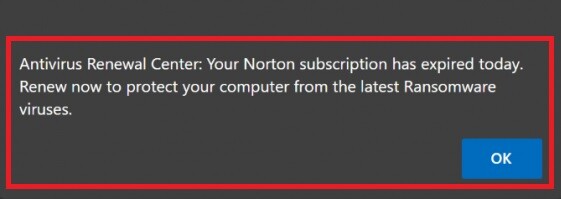Your Norton Has Expired Today
“Your Norton Has Expired Today” is a page that gets promoted by browser hijackers, and if you currently have this page imposed as the starting page in your browser, or there are continuous pop-ups on the bottom right of your computer that say “Your Norton Has Expired Today” , or if you are frequently getting page-redirected to it while you are surfing the Internet, then you most likely have a hijacker inside your computer, which you should remove.

The good news is that, by the end of this post, you will know all that you need to be able to remove the pesky software. However, before we tell you about the exact removal steps, let us first share with you some important information about the nature of such browser hijackers.
The Your Norton Has Expired Today Virus
If you have the hijacker behind the “Your Norton Has Expired Today” Virus in your Chrome, Safari, Edge or in another browser, you have most likely noticed some changes in the homepage, or the search engine, as well as some frequent page-redirects that send you to sites you did not intend to visit. The reason is, apps like the one responsible for promoting the “Your Norton Has Expired Today” Virus are mainly aimed at advertising different types of content directly from within the browsers of their users.
Most forms of online advertisement happens through different sites that have ads in them. However, a hijacker app removes the need of a site that serves as an advertising platform, and instead turns the user’s browser into a such platform. Some users find this really annoying and unpleasant, others do not mind the ads, the changes, and the page-redirects all that much and simply accept the presence of the hijacker without doing anything to remove it. And since most hijackers aren’t actually directly harmful to the system, having one in your computer will probably not lead to any serious damage. After all, those apps are very different from real computer malware, viruses, Trojans, Ransomware, etc.
The Norton Antivirus Expired Pop up
The Norton Antivirus Expired Pop up often reads: “Antivirus renewal center: Your Norton subscription has expired today. Renew now to protect your computer from the latest Ransomware viruses.”

Why you should still eliminate a hijacker when you see one
Even if you do not mind the irritating activities of the “Your Norton Has Expired Today” hijacker, you should still make sure to get it uninstalled, and here’s why:
One of the main issues with such apps, aside from their ability to annoy people, is the fact that there isn’t really all that much control over the content that they promote. As long as it makes a profit, and earns revenue, a given type of ads from a given source will get shown on the user’s screen regardless of whether or not the origin of these ads is safe and reliable. This means that you could easily get displayed sketchy ads from unreliable sources, which could, in turn, lead to the contamination of your computer with Trojans, viruses, Ransomware, or other similar malicious threats. Because of all this, we strongly recommend that you remove the “Your Norton Has Expired Today” page from your browser, and uninstall the hijacker related to it. To help you do that, we have prepared a guide, and posted it down below, so make sure to use it in order to uninstall and fully remove the unwanted software piece.
SUMMARY:
| Name | Your Norton Has Expired Today |
| Type | Browser Hijacker |
| Detection Tool |
Some threats reinstall themselves if you don’t delete their core files. We recommend downloading SpyHunter to remove harmful programs for you. This may save you hours and ensure you don’t harm your system by deleting the wrong files. |
Remove Your Norton Has Expired Today Virus
You are dealing with a malware infection that can restore itself unless you remove its core files. We are sending you to another page with a removal guide that gets regularly updated. It covers in-depth instructions on how to:
1. Locate and scan malicious processes in your task manager.
2. Identify in your Control panel any programs installed with the malware, and how to remove them. Search Marquis is a high-profile hijacker that gets installed with a lot of malware.
3. How to clean up and reset your browser to its original settings without the malware returning. You can find the removal guide here.
For mobile devices refer to these guides instead: Android, iPhone

Leave a Reply